Photograph by Ing-On Vibulbhan-Watts
I went to Thailand to visit my family for two months, from July and August 2017. I did not visit home since 2006. I was glad to see my family. I enjoyed seeing all new development in Bangkok and loved eating authentic Thai food, especially Thai fruits.
I had a chance to visit my home town, Lopburi, where I was raised when I was young, before we moved to Bangkok. I traveled to Ayutthaya to see the ruins of temples that were burned by Burmese soldiers, when the Burmese wanted to take over Thailand, The Burmese–Siamese War (1765–1767). Ayutthaya was one of the former capitals of Thailand before moved to, Thonburi and then Bangkok. I also traveled to, Chiang Mai, located in the Northern part of Thailand. Chiang Mai is the second largest and second most popular city of Thailand.
John, my husband came to Thailand in August. He joined me traveling to different part of Thailand. I had a good time taking videos and photographs wherever I traveled around Bangkok and other part of Thailand. I hope the viewers of my website will enjoy the photographs that I present in these projects.
Ing-On Vibulbhan-Watts, Thursday, October 26, 2017
Monkeys at Phra Prang Sam Yot, Lop Buri,Thailand
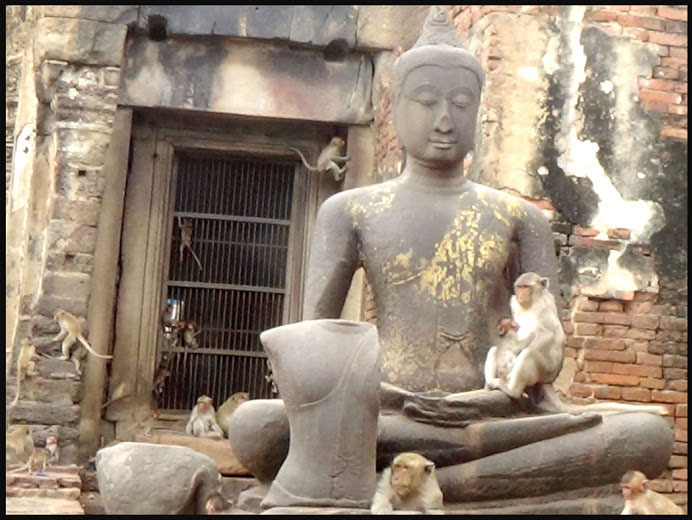 “Lopburi Monkey Banquet 2017:
“Lopburi Monkey Banquet 2017:
The festival starts at 10am, amongst the overgrown Khmer ruins that the monkeys call home. The Phra Prang Sam Yot temple, located on Vichayen Road about 200m from the railway station, is easy to find. The preamble consists of musical performances and human monkey dances (a scene of which you can witness for yourself in the documentary Baraka). After a speech by the Governor of Lopburi, the monkeys are then invited down to eat from the buffet tables. Initially shy, the monkeys are surprisingly well-behaved, even timid, in view of the hundreds of spectators gathered to watch them eat off long tables draped in red cloth. Invitations are attached to cashew nuts and distributed among the macaque guests, while chefs prepare an abundant spread including sticky rice, tropical fruit salad frozen in ice blocks and an egg-yolk dessert known as thong yod.
Food Fight! Eventually the monkey diners get acclimated to the curious spectators, and suddenly they’re dancing on the tables, throwing soda at each other, flinging pudding and causing a ruckus. The lavish feast soon vanishes, most of it inside the satisfied monkeys’ bellies, though a fair amount ends up on the ground, leaving the luncheon guests to conclude their wildly unhinged behavior by swinging up a few branches to take a treetop nap.
While this is one of those strange festivals that ranks up there with the likes of the El Colacho baby-jumpers or the Kanamara Matsuri penis festival, it’s also a rather simple and pure one that really speaks to a central aspect of Thai culture. The significance of monkeys in throughout Thai history and the fact that they are able to co-exist cannot be overstated. In monkeys we see a harrier, exaggerated version of ourselves, and are reminded that no matter how different we are, tolerance brings good fortune to all.”
For more information please visit the following link:
https://www.everfest.com/e/lopburi-monkey-banquet-lopburi-thailand
 Monkey’s Sculpture at Lop Buri Railway Station, Thailand
Monkey’s Sculpture at Lop Buri Railway Station, Thailand
“Explore the ruins: The Phra Prang Sam Yot temple will take you a day to absorb. It’s in the Bayon style of Khmer architecture, like the more famous Angkor Wat, and is characterized by distinctive Khmer elements such as bas-relief and blind doors or windows.”
For more information please visit the following link:
https://www.everfest.com/e/lopburi-monkey-banquet-lopburi-thailand 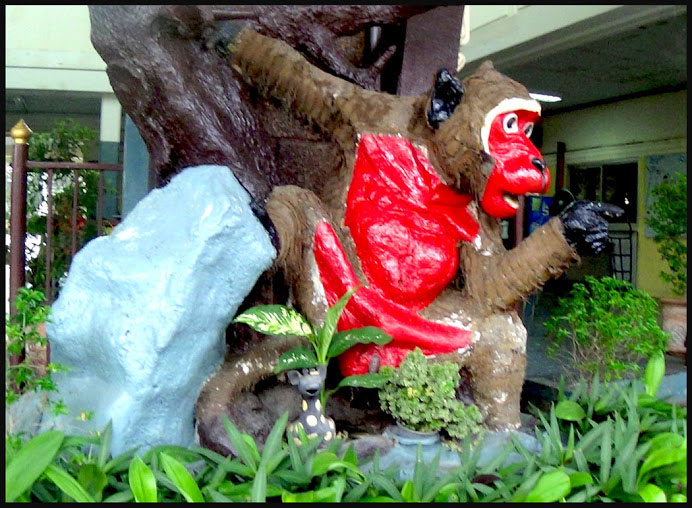 Monkey’s Sculpture at Lop Buri Railway Station, Thailand
Monkey’s Sculpture at Lop Buri Railway Station, Thailand
“When it comes to interacting with the monkeys, there are a few things to keep in mind: Don’t look them directly in the eyes, as they perceive this as a challenge or threat (and can attack). Don’t smuggle food in your purse or pants (they will know). Overall, be kind and stay relaxed. Animals are sensitive to energy, and while a stick for self-defense comes with the 20-baht entrance fee, try not to use it. They might steal your stuff, but don’t forget that you’re a guest at their dinner party.
For more information please visit the following link:
https://www.everfest.com/e/lopburi-monkey-banquet-lopburi-thailand 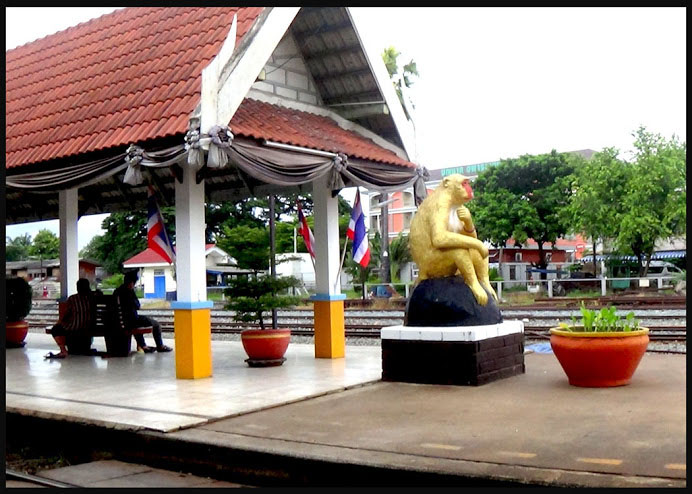 Monkey’s Sculpture at Lop Buri Railway Station, Thailand
Monkey’s Sculpture at Lop Buri Railway Station, Thailand
“Transportation: The main road through Lobpuri is Route 1 (Phahonyothin Road), which starts in Bangkok, and continues through Lopburi, Chai Nat, Nakhon Sawan, Kamphaeng Phet, Tak, Lampang, Chiang Rai, and the border with Burma at Mae Sai. Route 311 leads west to Sing Buri, and Route 3196 leads south-west to Ang Thong.
Lopburi is a station of the State Railway of Thailand’s Northern Line, forming the end of Bangkok’s suburban service.
Lopburi is served by the Khok Kathiam airport, 9 kilometres (5.6 mi) north of the town.”
For more information please visit the following link:
https://en.wikipedia.org/wiki/Lopburi
 Monkeys at Phra Prang Sam Yot, Lop Buri, Thailand
Monkeys at Phra Prang Sam Yot, Lop Buri, Thailand
“Lopburi Monkey Festival (Last weekend in November)
The provincial capital of Lopburi in Central Thailand is home to countless monkeys that have adapted to life in an urban environment. The monkeys have become such a part of the local culture that there is actually a festival held in their honor – the Lopburi Monkey Festival.”
For more information please visit the following link:
https://www.discoverythailand.com/Lop_Buri_Lopburi_Monkey_Festival.asp
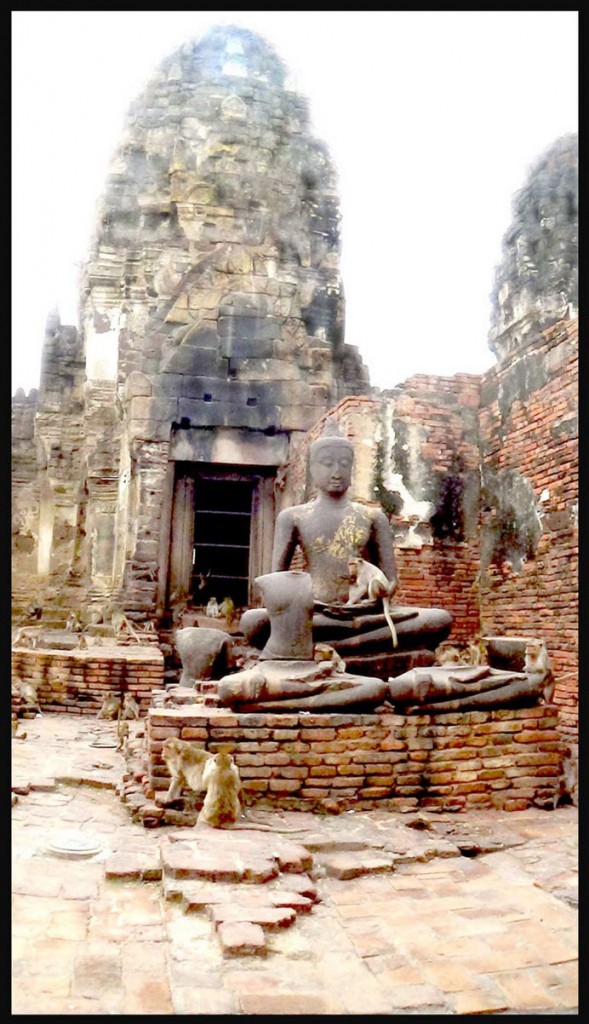 Monkeys at Phra Prang Sam Yot, Lop Buri, Thailand
Monkeys at Phra Prang Sam Yot, Lop Buri, Thailand
“The annual festival takes place on the last weekend in November and is a major attraction for locals and foreign visitors alike. Festivities include a monkey ‘tea party’ where macaques tuck into a spread of fruit, eggs, cucumbers and bananas all prepared in their honour. Last year the monkeys got through around 2,000 kilograms of food provided by locals who believe donating the food will bring them good fortune.”
For more information please visit the following link:
https://www.discoverythailand.com/Lop_Buri_Lopburi_Monkey_Festival.asp
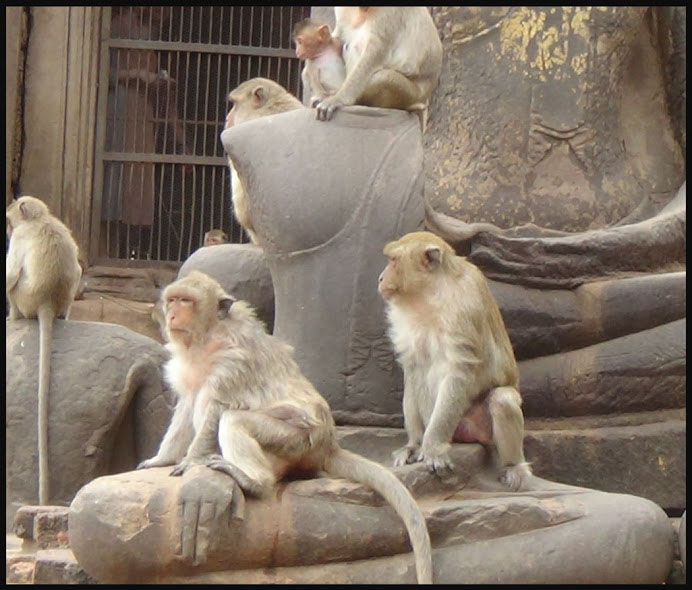 Inside Phra Prang Sam Yot, Lop Buri, Thailand
Inside Phra Prang Sam Yot, Lop Buri, Thailand
“Religion: Phra Prang Sam Yot, originally a Hindu shrine, has three prangs that represent Brahma, Vishnu, and Shiva (the Hindu trinity). It was later converted to a Buddhist shrine.”
For more information please visit the following link:
https://en.wikipedia.org/wiki/Lopburi
There are no monkeys inside the temple but one can see the small monkeys climbing up the protected windows outside of Phra Prang Sam Yot. 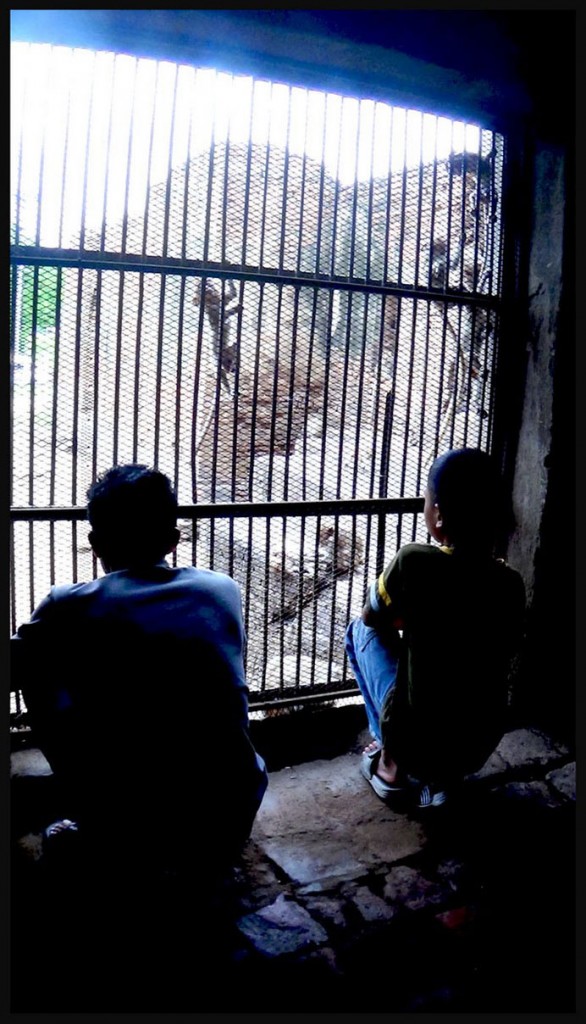 Inside Phra Prang Sam Yot, Lop Buri, Thailand
Inside Phra Prang Sam Yot, Lop Buri, Thailand
There are some Buddha statues without heads inside Phra Prang Sam Yot.
“Phra Prang Sam Yot: Located on Vichayen Road, approximately 200 meters from the railway station, Phra Prang Sam Yot is Lop Buri’s best known landmark and provincial symbol. A former Hindu shrine built in the 13th century in the classic Bayon style of Khmer architecture, the compound comprises three Prangs (towers) linked by corridors. The three laterite and sandstone spires, each decorated with classic stucco, are believed to have originally represented the Hindu Trimurti; Brahma (the Creator), Vishnu (the Preserver) and Shiva (the Destroyer).
During the reign of King Narai, the shrine was converted into a Buddhist temple and a brick hall was built in the east to house a grand U Thong-style Buddha image. Buddha images were later added to the two Prangs.
The temple is located on a mound on the west side of the railway, near San PhraKan, another shrine.”
For more information please visit the following link:
https://www.tourismthailand.org/Attraction/Phra-Prang-Sam-Yot–926
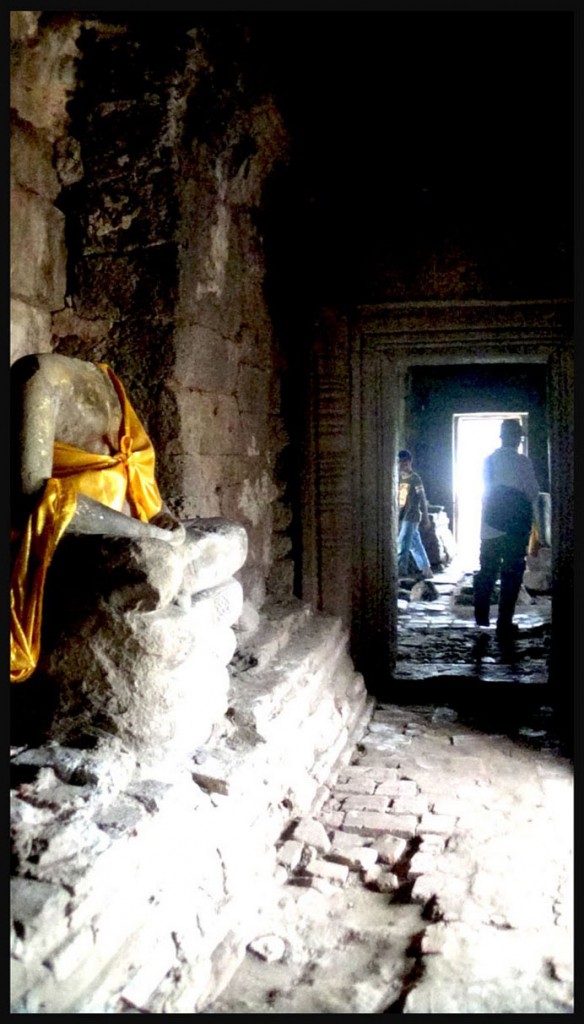
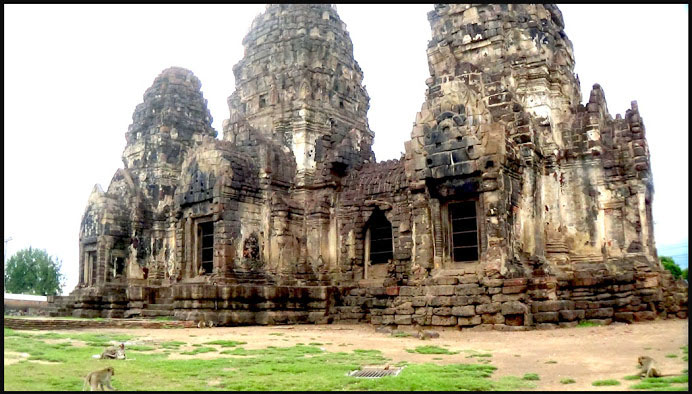 Monkeys at Phra Prang Sam Yot, Lop Buri, Thailand
Monkeys at Phra Prang Sam Yot, Lop Buri, Thailand
“Lopburi Monkey Banquet 2017: Three thousand macaques tuck into a lavish feast that includes two tons of fresh produce, rice, ice cream and other treats. Once the first banana is thrown, the rest isn’t far behind.
About This Festival: In central Thailand’s provincial capital of Lopburi, about 150 kilometers north of Bangkok, the last Sunday in November is reserved for the Lopburi Monkey Banquet. The world’s wildest dinner party is held in honor of these long-tailed macaques, who have become integrated into local society despite their pick-pocketing tendencies and mercurial attitudes.”
For more information please visit the following link: https://www.everfest.com/e/lopburi-monkey-banquet-lopburi-thailand
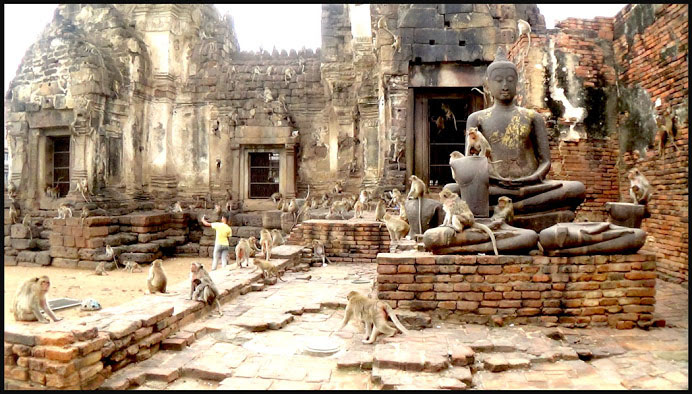 Monkeys at Phra Prang Sam Yot, Lop Buri, Thailand
Monkeys at Phra Prang Sam Yot, Lop Buri, Thailand
“To understand the significance of this banquet, one must first appreciate the role monkeys play in Lopburi culture. These fellow primates are part of society, having free reign of the town and the ability to enter public buildings and traverse roads like any other citizen. They can be a nuisance, stealing from locals and tourists alike, and are generally mischievous and destructive. The townspeople have a firm belief that they bring good luck and fortune, however, and thus are patient (at the very least the monkeys bring fortune in the form of tourist baht, the local currency).”
For more information please visit the following link: https://www.everfest.com/e/lopburi-monkey-banquet-lopburi-thailand
 Monkeys at Phra Prang Sam Yot, Lop Buri, Thailand
Monkeys at Phra Prang Sam Yot, Lop Buri, Thailand
The veneration of monkeys dates back to the monkey deity Hanuman and his monkey army, who saved Sita, the wife of Lord Ram, from the clutches of a demon. Since then, the Thai people have viewed monkeys as descendants of this heroic deity and continue to respect this petulant creature. Among those who worship these monkeys is Yongyuth Kitwatananusont, the owner of the Lopburi Inn. In front of his hotel is a large monkey statue, which he has been using as a symbol for many years. Business has been good for both him and other people working in the tourism sector, and after attributing his success to the monkeys, he decided one year to create a buffet for them. The first one took place in 1989, and it’s taken place annually ever since.
For more information please visit the following link: https://www.everfest.com/e/lopburi-monkey-banquet-lopburi-thailand
 Monkey stole Ing’s drink, Lop Buri,Thailand
Monkey stole Ing’s drink, Lop Buri,Thailand
My husband, John and I had only a few days left before returning home to Newark, New Jersey. We decided to pack our bags for the journey home, and take only a day trip outside of Bangkok. We had to leave for the airport by Monday evening, so we had Sunday, August 27, 2017 available for a short-day trip. We got up early and took a two-hour train ride to, Lop Buri, my home town where I lived since I was young, and where I graduated from high school. Near the Lop Buri train station were two ruins of temples, Wat Bundai Hin, and Wat Phrasrirattana Mahathat. We enjoyed viewing and photographing the temples. Then we walked to anther of Lop Buri’s famous monuments, called, Phra Prang Sam Yot, where there are hundreds of monkeys called, crab-eating macaques. There is a special occasion called, “The Lopburi Monkey Festival”, to celebrate these monkeys.
We bought drinks from a shop along the way. John had a soda and I had an orange drink, which I drank slowly while we were walking to, Phra Prang Sam Yot. We saw the ruins not very far from us as suddenly I felt someone snatch my bottle away from me as I was drinking the juice. I looked at my right and saw a monkey drinking my orange drink as he watched carefully so that the other monkey who was near him would not take the drink away. Quickly I pulled out my camcorder and recorded the monkey drinking from my bottle. I was not sorry about losing my drink, because it was a great opportunity to take the best pictures and story without any planning.
Ing-On Vibulbhan-Watts, Thursday, August 31, 2017
“Lopburi (Thai: , RTGS: Lop Buri, pronounced [lóp b]) is the capital city of Lopburi Province in Thailand. It is about 150 kilometres (93 mi) north-east of Bangkok. As of 2006 it had a population of 26,500. The town (thesaban mueang) covers the whole tambon Tha Hin and parts of Thale Chup Son of Mueang Lopburi district, a total area of 6.85 km². Lopburi lies 138 km north of Bangkok.
Culture: Today the city is best known for the hundreds of crab-eating macaques (Macaca fascicularis) that live in the middle of the city, especially around the Khmer temple, Prang Sam Yot and a Khmer shrine, Sarn Phra Karn. They are fed by the local people, especially during the Monkey Festival in November. Because they are not afraid of humans, they steal whatever items or food they can find from unwary visitors.
In the city signs are posted reading: To prevent monkeys attacking people, the officer will feed monkeys in 3 designated areas outside San Phrakan twice a day, at 10am and 4pm. Those who want to feed monkeys other than these times, please contact the officer or caretaker.”
For more information please visit the following link:
https://en.wikipedia.org/wiki/Lopburi
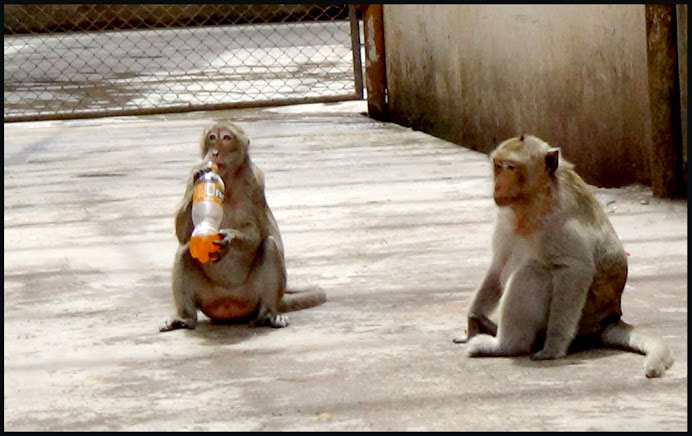 Monkey stole Ing’s drink, Lop Buri,Thailand
Monkey stole Ing’s drink, Lop Buri,Thailand
“Etymology: It was originally known as Lavo or Lavapura, meaning “city of Lava” in reference to the ancient South Asian city of Lavapuri (present-day Lahore).[1]
History: The city has a history dating back to the Dvaravati period more than 1,000 years ago.[2]:302,308 According to the Northern Chronicles, it was founded by King Kalavarnadish (Thai, “Phraya Kalavarnadit”), who came from Taxila (Takkasila) in north-west India (now Pakistan) in 648 CE.[3] Lopburi, or Lavapura as it then was, was under the rule of the rising Angkor regime and became one of the most important centers in the Chao Phraya Basin from then on.[4] Epigraphic evidence indicates that the dominant population of the city was Mon.[5]
The earliest confirmed occurrence of the name Lavapura is on silver coins inscribed “lava” on the obverse and “pura” on the reverse in a Pallava-derived script of the seventh or eighth century; several such coins were recovered in 1966 from a hoard found in an ancient jar in U Thong.[6][7]
There is some evidence the Khmer Empire, under Suryavarman II, fought against the Mons in the 12th century over suzerainty. Lopburi sent embassies to China in 1115 and 1155.[8]:161”
For more information please visit the following link:
https://en.wikipedia.org/wiki/Lopburi
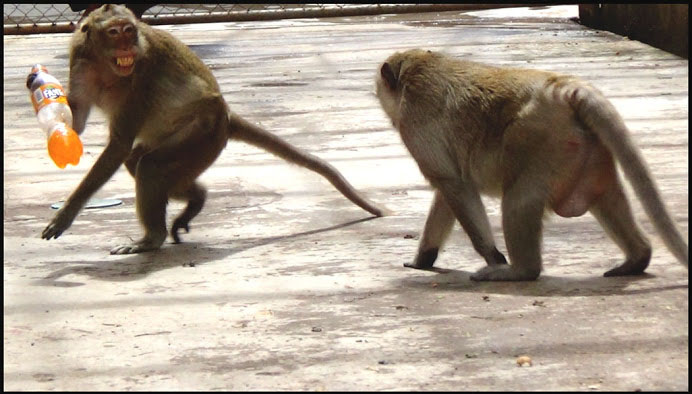 Monkey stole Ing’s drink, Lop Buri,Thailand
Monkey stole Ing’s drink, Lop Buri,Thailand
“Lopburi (Lavo) is described in Book III of Marco Polo’s Travels, where it is called Locach. This came from the Chinese (Cantonese) pronunciation of Lavo, “Lo-huk”.[9] The city is referred to as “Lo-ho” in chapter 20 of the History of Yuan (?? : Yuán Sh?), the official history of the Mongol, or Yuan Dynasty of China. Due to a scribal error in Book III of Marco Polo’s travels treating of the route southward from Champa, where the name Java was substituted for Champa as the point of departure, Java Minor was 1,300 miles to the south of Java Major, instead of from Champa, on or near an extension of the Terra Australis.[10] As explained by Sir Henry Yule, the editor of an English edition of Marco Polo’s Travels: “Some geographers of the 16th century, following the old editions which carried the travellers south-east of Java to the land of Boeach (or Locac), introduced in their maps a continent in that situation”.[11]
After the foundation of the Ayutthaya Kingdom in the 14th century, Lopburi was a stronghold of Ayutthaya’s rulers. It became the capital of the kingdom during the reign of King Narai the Great in the mid-17th century and the king resided there about eight months a year.”
For more information please visit the following link:
https://en.wikipedia.org/wiki/Lopburi

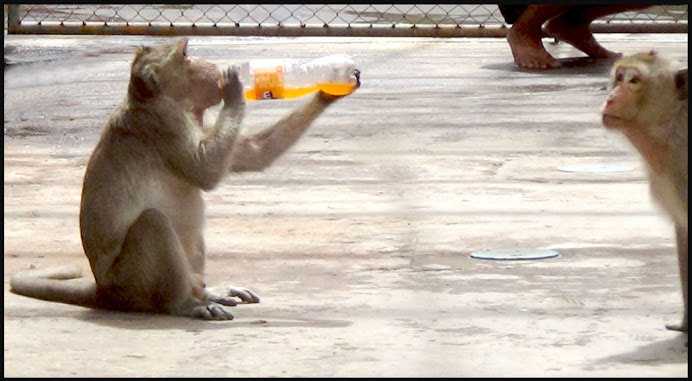 Monkey stole Ing’s drink, Lop Buri,Thailand
Monkey stole Ing’s drink, Lop Buri,Thailand
“Geography: Lopburi lies on the Lopburi River at an elevation of 20 metres (66 ft) mostly surrounded by alluvial plains, although some hills rise to between 300 metres (980 ft) and 600 metres (2,000 ft) to the north-east.
Climate: Lopburi has a tropical savanna climate (Köppen climate classification Aw). Winters are dry and very warm. Temperatures rise until April, which is very hot with the average daily maximum at 36.8 °C (98.2 °F). The monsoon season runs from late April through October, with heavy rain and somewhat cooler temperatures during the day, although nights remain warm.”
For more information please visit the following link: https://en.wikipedia.org/wiki/Lopburi
 Thai Folk Dance Mural at the Thai Airport, Thailand, June 27, 2017
Thai Folk Dance Mural at the Thai Airport, Thailand, June 27, 2017
Welcome To My Beloved Country, Thailand
Photograph by Ing-On Vibulbhan-Watts
Sri-Nuan is a typical dance of central Thailand. Its great popularity is due to the choreography and the sweetness of the music that accompanies it. The lyrics and music evoke the sweet nature of Thai girls. The dance is also an expression of the yearning of a young man won by such great charm.
Teut-teung (drum dance) The teut-teung drum, an instrument used in Thai folk music, is played throughout the country to accompany the parades held at traditional festivals. It is said that the modern style of the teut-teung dance was created by some music teachers.
Farmers Dance (rice grower dance): This is a modern dance created by the Thai Ministry of Culture. The dancers wear the rice grower traditional costume and the dance itself enacts the daily activities of these workers who are the backbone of the nation. The ballet opens with the farmers as they come to plow and sow the fields. When they are sure that the rice is growing well, they gather together to pray to Mae Po Sop, the goddess who protects rice-growing. Lastly, the harvest is celebrated with songs and dancing.
Krabi Krabong or Combat with Short and Long Sticks and with Swords These dances are inspired by types of combat that were typical of Thailand, in which either sticks or swords are used. The skillful use of the short stick depends on the agility of the fighter, who must attack and always remain close to his opponent, while the combatant who takes up the long stick must maintain a critical distance from his rival to use his weapon effectively. The art of sword fighting has been practiced in Thailand since the beginning of time, and, traditionally, a ceremonial dance is performed prior to combat.[citation needed]
For more information please visit the following link:
https://en.wikipedia.org/wiki/Dance_in_Thailand
 Thai Folk Dance Mural at the Thai Airport, Thailand, June 27, 2017
Thai Folk Dance Mural at the Thai Airport, Thailand, June 27, 2017
“Dance in Thailand (Thai: ram Thai) is the main dramatic art form of Thailand. Thai dance, like many forms of traditional Asian dance, can be divided into two major categories that correspond roughly to the high art (classical dance) and low art (folk dance) distinction.
Although the traditional Thai performing arts are not as vibrant as they once were, suffering inroads from Western entertainment and generally changing tastes, Thai dance drama is not extinct. What survives displays the elegance of an art form refined over centuries and supported by regal patronage.
Aside from folk and regional dances (southern Thailand’s Indian-influenced manohra dance, for example), the two major forms of Thai classical dance drama are khon and lakon nai. In the beginning, both were exclusively court entertainments and it was not until much later that a popular style of dance theater, likay, evolved as a diversion for the common folk who had no access to royal performances.[citation needed]”
For more information please visit the following link: https://en.wikipedia.org/wiki/Dance_in_Thailand
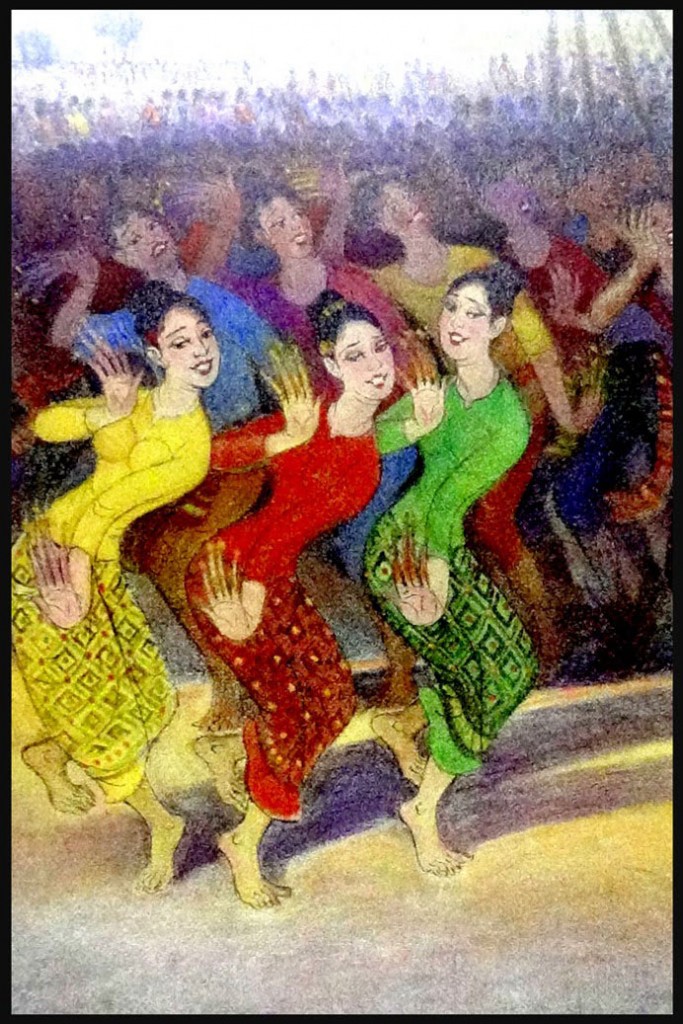 Thai Folk Dance Mural at the Thai Airport, Thailand, June 27, 2017
Thai Folk Dance Mural at the Thai Airport, Thailand, June 27, 2017
“Thai classical dance drama include Khon, Lakhon, and Fawn Thai.
The first detailed European record of Khôn and other Thai classical dances was made during the Ayutthaya Kingdom showing the tradition and styles of dramatic art which were almost identical to the Thai traditions we still see today. Historical evidence clearly establishes that the Thai art of stage plays must have already been perfected by the 17th Century. Louis XIV, the Sun King of France, had a formal diplomatic relation with Ayutthaya’s King Narai. In 1687, France sent the diplomat Simon de la Loubère to record all that he saw in the Siamese Kingdom and its traditions. In his famous account “Du Royaume de Siam”, La Loubère carefully observed the classic 17th-century theatre of Siam, including an epic battle scene from a Khon performance, and recorded what he saw in great details:
“The Siamese have three sorts of Stage Plays: That which they call Cone [Khôn] is a figure dance, to the sound of the violin and some other instruments. The dancers are masked and armed, and represent rather a combat than a dance. And though every one runs into high motions, and extravagant postures, they cease not continually to intermix some word. Most of their masks are hideous, and represent either monstrous Beasts, or kinds of Devils. The Show which they call Lacone is a poem intermix with Epic and Dramatic, which lasts three days, from eight in the morning till seven at night. They are histories in verse, serious, and sung by several actors always present, and which do only sing reciprocally …. The Rabam is a double dance of men and women, which is not martial, but gallant … they can perform it without much tying themselves, because their way of dancing is a simple march round, very slow, and without any high motion; but with a great many slow contortions of the body and arms.”[1]
Of the attires of Siamese Khôn dancers, La Loubère recorded that:
“[T]hose that dance in Rabam, and Cone, have gilded paper-bonnets, high and pointed, like the Mandarins caps of ceremony, but which hang down at the sides below their ears, which are adorned with counterfeit stones, and with two pendants of gilded wood.”[2]
La Loubère also observed the existence of Muay Thai and Muay Laos, noting that they looked similar (i.e. using both fists and elbows to fight) but the hand-wrapping techniques were different.[2]
The accomplishment and influence of Thai art and culture, developed during the Ayutthaya period, on the neighboring countries was evident from the observation of James Low, a British scholar on Southeast Asia and a Captain, during the early Rattanakosin Era:
“The Siamese have attained to a considerable degree of perfection in dramatic exhibitions — and are in this respect envied by their neighbours the Burmans, Laos, and Cambojans who all employ Siamese actors when they can got.”[3]”
For more information please visit the following link: https://en.wikipedia.org/wiki/Dance_in_Thailand
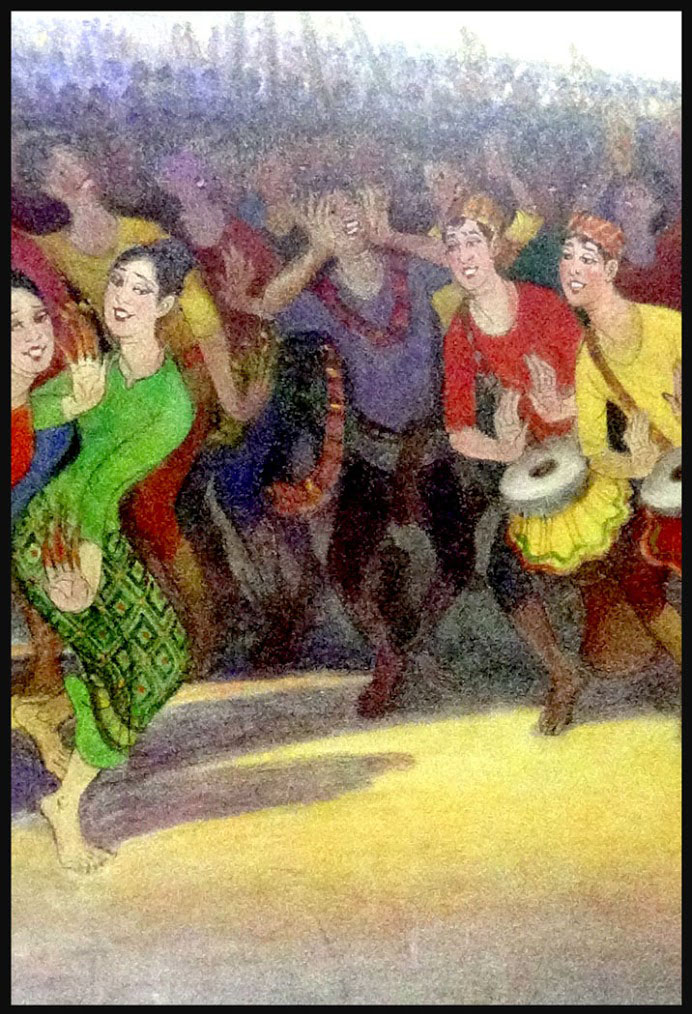 Thai Folk Dance Mural at the Thai Airport, Thailand, June 27, 2017
Thai Folk Dance Mural at the Thai Airport, Thailand, June 27, 2017
“Khon is the most stylized form of Thai dance. It is performed by troupes of non-speaking dancers, the story being told by a chorus at the side of the stage. Choreography follows traditional models rather than attempting to innovate. Most khon performances feature episodes from the Ramakien. Costumes are dictated by tradition, with angels, both good and bad, wearing coloured masks.
Lakhon features a wider range of stories than khon, including folk tales and Jataka stories. Dancers are usually female and perform as a group rather than representing individual characters.
Fawn is another form of “folk-dance” accompanied by the folk music of the region. The first Fawn originated from the northern region of Thailand, it was designed and taught by Chao Dararasami of Chiang Mai. Since then, a variety of “Fawn” came into practice, according to the music and style of each province, such as the Fawn-Lep fingernail dance from Chiang Mai, Fawn-Ngiew from Chiang Rai with the influence of Burmese music and costume.
Fawn Thai is divided into three types:
Fawn Leb (Fingernails Dance)
Fawn leb is a Northen Thai dance style, each dancer wears 6-inch long brass fingernail. The long fingernail accentuated the finger movement of each dancer. Dancer wore chignon style with yellow flower like tiara with long chain jasmine flower.
Fawn Tian (Candle Dance)
Fawn Tian consists of eight dancers carrying candles in their hand. The choreographed position is usually divided into pairs of two, one each side. The wore full-length sarong and jackets with a matching shoulder cloth. This dance is always held at night.
Fawn Ngiew (Scarf Dance)
Fawn Ngiew is a dance in which is shown or perform in a happy event. The dance is similar to the Fawn Leb but the dance is faster and more fun. Each dancer wore a yellow flower tiara, Jong Kra Bane, and Sabai.”
For more information please visit the following link: https://en.wikipedia.org/wiki/Dance_in_Thailand
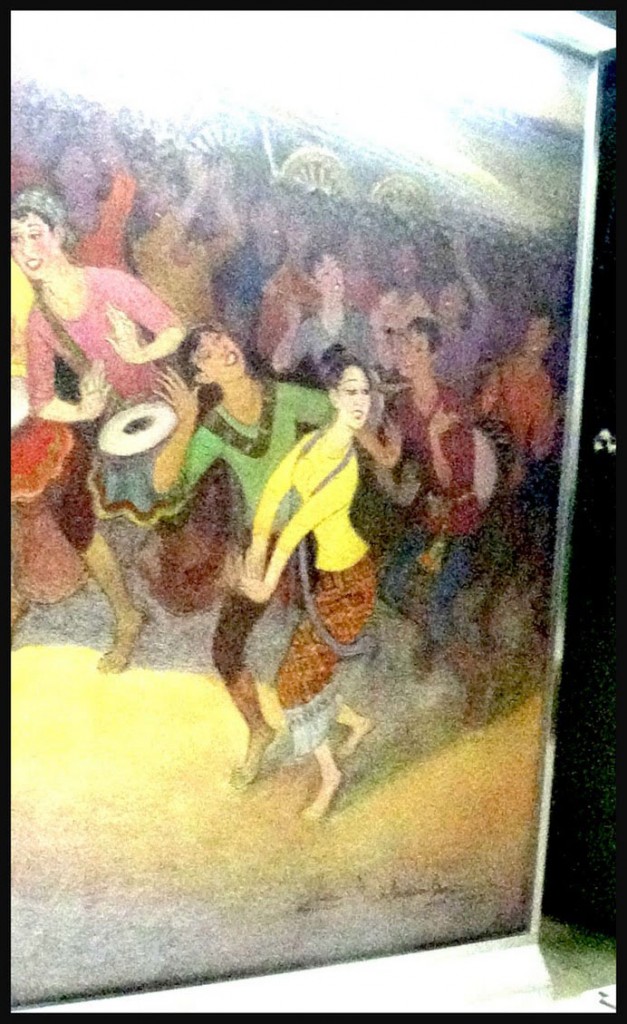 Thai Folk Dance Mural at the Thai Airport, Thailand, June 27, 2017
Thai Folk Dance Mural at the Thai Airport, Thailand, June 27, 2017
“Folk dance forms include dance theater forms like Likay, numerous regional dances (“ram”), the ritual dance Ram Muay, and homage to the teacher, Wai Khru. Both Ram Muay and Wai Khru take place before all traditional Muay Thai matches. The Wai is also an annual ceremony performed by Thai classical dance groups to honor their artistic ancestors.
Ramwong (????) is a type of partner dance in a circle.
Ram Muay (?????) is the ritualized dance that takes place before Southeast Asian kickboxing matches such as muay Thai.
Wai Khru (???????) Wai khru ram muay is a ritualized form of dance meant to pay respect to or homage to the khru or teacher. It is performed annually by Thai classical dance institutions as well as before muay Thai matches.”
For more information please visit the following link: https://en.wikipedia.org/wiki/Dance_in_Thailand 
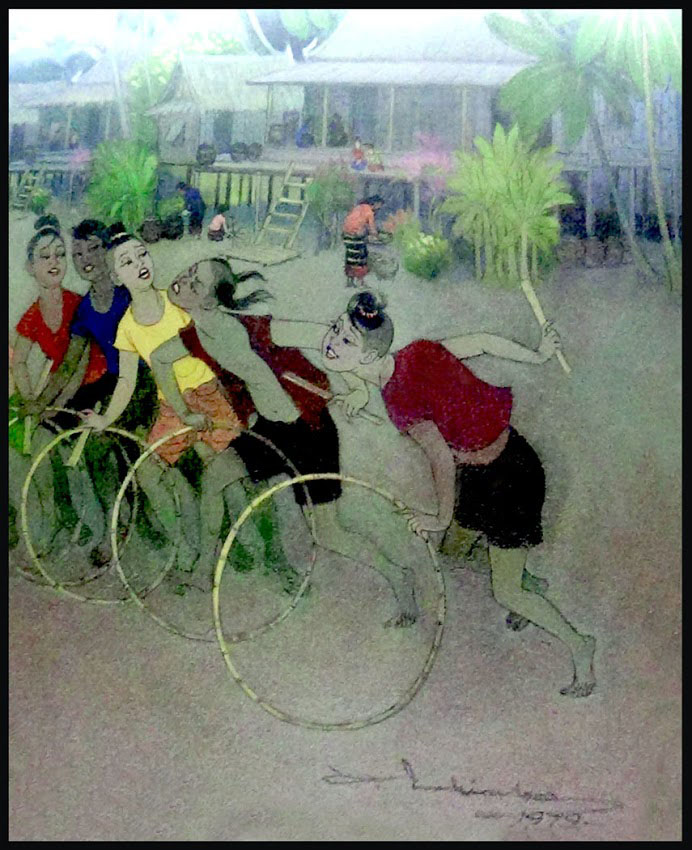 Thai Children Game Mural at the Thai Airport, Thailand
Thai Children Game Mural at the Thai Airport, Thailand
Welcome To My Beloved Country, Thailand
Photograph by Ing-On Vibulbhan-Watts
Hitting Circular bamboo wood
In the game, children compete with each other to see how far and how fast they can hit the circular bamboo wood.
Other Children Games
Ngoo Kin Hang / Tail-Eating Snake
The aim of the game is for the Father Snake to try to outwit the Mother Snake and catch one of the Baby Snakes that she is trying to protect. A very old game, Tail Eating Snake is traditionally played during the Songkran festivals and other special cultural events.
E-Keb / Throwing and Catching Rocks
Tai Yai group, Mae Hong Sorn Province, Thailand
Players have to throw a small stone into the air and before catching it, pick up a number of other rocks and handle them in a particular sequence of movements.
Other Children Games
Ree Ree Khao Sarn / To be Trapped Between the Arches
The aim of the game is for players to pass under an archway that is formed by their opponent’s arms without being trapped.
For more information please visit the following link: https://www.unescobkk.org/culture/ich/children-games/games/a-z/
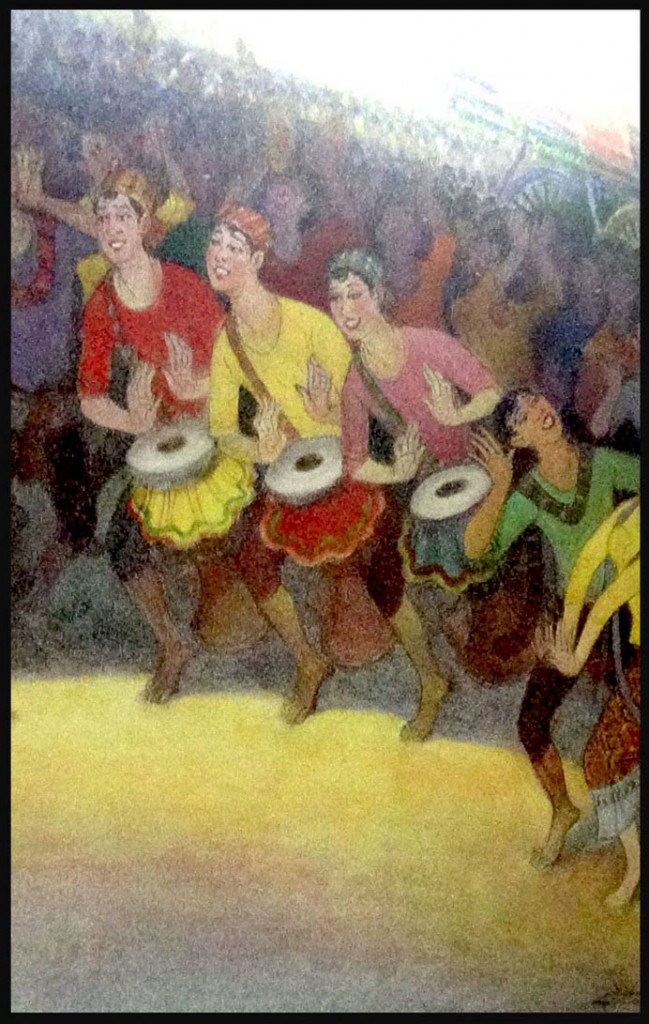
Leave a Reply